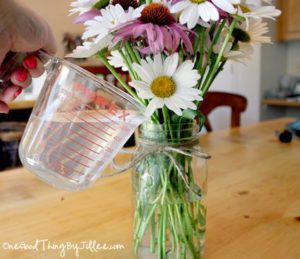Vinegar is Your Friend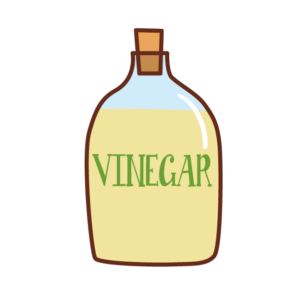
PERSPECTIVE
Single-use packaging creates so much waste, and cleaning supplies are certainly notorious for this. Plus, the nasty, often toxic chemicals in most commercial cleansers are just not necessary! Instead, a very useful bulk product is always nearby and ready to serve, with little or no extra preparation but extra-ordinary results.
Yes, VINEGAR – – in White or Apple Cider form – – goes a long way toward replacing expensive and wasteful containers of fancier (and harsher) cleaners.
PRACTICAL
In our kitchen we keep a spray bottle of diluted White Vinegar nearby for all sorts of spot uses, such as cleaning off the surfaces of fruits and veggies, not to mention countertops and cutting boards.
 Jillee, in her blog One Good Thing, has a very thorough line-up of “50 Amazing Uses For Vinegar,” including how to make your own Apple Cider Vinegar!
Jillee, in her blog One Good Thing, has a very thorough line-up of “50 Amazing Uses For Vinegar,” including how to make your own Apple Cider Vinegar!
Which is its own amazing resource, as diagramed by Leah Segedie on her blog about living free of chemicals, MAMAVATION, in “25 Ways Apple Cider Vinegar Will Change Your Life.” 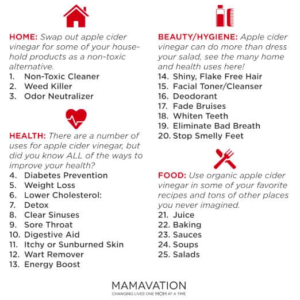
And Readers Digest has a long list of “Household Vinegar Uses You Never Knew About,” from which here are a good bunch of my (edited) favorites:
Clear dirt off PCs and peripherals
 Mix equal parts white vinegar and water, dampen a clean cloth in the solution (DON’T use a spray bottle), squeeze it out and start wiping. Use cotton swabs to get in tight spaces (like around the keys of your keyboard).
Mix equal parts white vinegar and water, dampen a clean cloth in the solution (DON’T use a spray bottle), squeeze it out and start wiping. Use cotton swabs to get in tight spaces (like around the keys of your keyboard).
Erase ballpoint-pen marks
Dab full-strength white vinegar on the marks using a cloth or a sponge. Repeat until the marks are gone.
Burnish your scissors
Avoid using water to clean scissors. Instead, wipe down the blades with a cloth dipped in full-strength white vinegar, and then dry with a rag or dish towel.
Clean your window blinds
Use “the white glove treatment.” Just put on a white cotton glove and moisten the fingers in a solution made of equal parts white vinegar and hot tap water. Then slide your fingers across both sides of each slat and prepare to be amazed. Use a container of clean water to periodically wash off the glove.
Get rid of water rings on tables
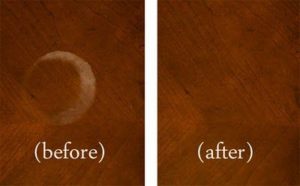 To remove marks left by wet glasses on wood furniture, mix equal parts vinegar and olive oil and apply it with a soft cloth while moving with the wood grain. Use another clean, soft cloth to shine it up.
To remove marks left by wet glasses on wood furniture, mix equal parts vinegar and olive oil and apply it with a soft cloth while moving with the wood grain. Use another clean, soft cloth to shine it up.
Restore your rugs
Brushing worn and dingy carpets with a clean push broom dipped in a solution of 1 cup white vinegar in 1 gallon water. No need to rinse off the solution.
Remove more stubborn carpet stains
- Rub light carpet stains with a mixture of 2 tablespoons salt dissolved in 1/2 cup white vinegar. Let the solution dry, then vacuum.
- For larger or darker stains, add 2 tablespoons borax to the mixture and use in the same way.
- For tough, ground-in dirt and other stains, make a paste of 1 tablespoon vinegar and 1 tablespoon cornstarch, and rub it into the stain using a dry cloth. Let it set for two days, then vacuum.
- To make spray-on spot and stain remover, fill a spray bottle with 5 parts water and 1 part vinegar. Fill a second spray bottle with 1 part non-sudsy ammonia and 5 parts water. Saturate a stain with the vinegar solution. Let it settle for a few minutes, then blot thoroughly with a clean, dry cloth. Then spray and blot using the ammonia solution. Repeat until the stain is gone.
Remove candle wax from wood surfaces
First soften the wax using a blow-dryer on its hottest setting and blot up as much as you can with paper towels. Then remove what’s left by rubbing with a cloth soaked in a solution made of equal parts white vinegar and water. Wipe clean with a soft, absorbent cloth.
Unclog and deodorize drains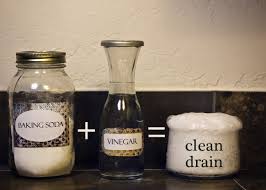
Use a funnel to pour 1/2 cup baking soda followed by 1 cup vinegar into the drain. When the foaming subsides, flush with hot tap water. Wait five minutes, and then flush again with cold water. Besides clearing blockages, this technique also washes away odor-causing bacteria.
Get rid of smoke odor
Place a shallow bowl about three-quarters full of white or cider vinegar in the room where the scent is strongest. Use several bowls if the smell permeates your entire home. The odor should be gone in less than a day. You can also quickly dispense of the smell of fresh cigarette smoke inside a room by moistening a cloth with vinegar and waving it around a bit.
Give grease stains the slip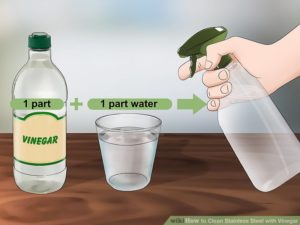
Wipe down greasy surfaces with a cloth dampened in a solution of equal parts white vinegar and water. For daily grease-fighting action, pour 3-4 tablespoons white vinegar into your liquid dishwashing detergent and give it a few shakes. The added vinegar will not only increase the detergent’s grease-fighting capabilities but also provide you with more dishwashing liquid for the money.
Steam-clean your microwave
Zap a glass bowl of 1/4 cup vinegar in 1 cup water for five minutes on the highest setting. Once the bowl cools, dip a cloth or sponge into the liquid and use it to wipe away stains and splatters on the interior.
Refresh your refrigerator
Use equal parts white vinegar and water to wash both the interior and exterior of your fridge, including the door gasket. Also, use undiluted vinegar to wipe off accumulated dust and grime on top of your refrigerator.
Disinfect cutting boards
Wipe them with full-strength white vinegar after each use. (Never use water and dishwashing detergent, because it can weaken surface wood fibers.) When your wooden cutting surface needs deodorizing as well as disinfecting, spread some baking soda over it and then spray on undiluted white vinegar. Let it foam and bubble for five to ten minutes, then rinse with a cloth dipped in clean cold water.
Shine your silver (including silver jewelry)
Soak them in a mixture of 1/2 cup white vinegar and 2 tablespoons baking soda for two to three hours. Rinse under cold water and dry thoroughly with a soft cloth.
Clean a coffeemaker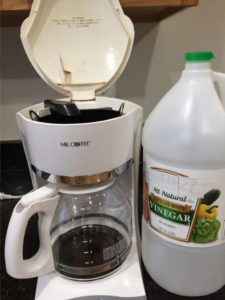
Fill the pot with 2 cups white vinegar and 1 cup water. Place a filter in the machine, and pour the solution into the coffeemaker’s water chamber. Run a full brew cycle, then remove the filter and replace it with a fresh one. Then run clean water through the machine for two more cycles, replacing the filter again for the second brew.
Clean cloudy or spotted glassware
 Heat up a pot of equal parts white vinegar and water (use full-strength vinegar if your glasses are very cloudy), and let them soak in it for 15-30 minutes. Give them a good scrubbing with a bottle brush, then rinse clean.
Heat up a pot of equal parts white vinegar and water (use full-strength vinegar if your glasses are very cloudy), and let them soak in it for 15-30 minutes. Give them a good scrubbing with a bottle brush, then rinse clean.
Clean a teakettle
To eliminate lime and mineral deposits in a teakettle, bring 3 cups full-strength white vinegar to a full boil for five minutes and leave the vinegar in the kettle overnight. Rinse out with cold water the next day.
Make an all-purpose scrub for pots and pans
Simply combine equal parts salt and flour and add just enough vinegar to make a paste. Work the paste around the cooking surface and the outside of the utensil, then rinse off with warm water and dry thoroughly with a soft dish towel.
Sanitize jars, containers, and vases
Fill the item with equal parts vinegar and warm, soapy water and let it stand for 10-15 minutes. If you’re cleaning a bottle or jar, close it up and give it a few good shakes; otherwise, use a bottle brush to scrape off the remains before thoroughly rinsing.
Trap fruit flies
Fill an old jar about halfway with apple cider vinegar. Punch a few holes in the lid, screw it back on, and you’re good to go.
Clean windshield wiper blades
Dampen a cloth or rag with some full-strength white vinegar and run it down the full length of each blade once or twice.
Care for your car’s carpets
After a good vacuuming, mix equal parts water and white vinegar and sponge it into the carpet. Let it settle for a few minutes, then blot up with a cloth or paper towel.
Remove bumper stickers and decals
Saturate the top and sides of the sticker with undiluted distilled vinegar and wait 10-15 minutes for the vinegar to soak through. Then use an expired credit card or the like to scrape it off. Use more full-strength vinegar to get rid of any remaining gluey residue.
Keep car windows frost-free
Wipe (or, better yet, spray) the outsides of the windows with a solution of 3 parts white vinegar to 1 part water. Each coating may last up to several weeks—although, unfortunately, it won’t do much in the way of warding off a heavy snowfall.
Shine ceramic tiles
Scrub them with 1/2 cup white vinegar, 1/2 cup ammonia, and 1/4 cup borax mixed in 1 gallon warm water. Rinse well with cool water and let air-dry.
Remove mineral deposits from showerheads
- Removable showerheads: place in 1 quart boiling water with 1/2 cup distilled vinegar for 10 minutes (use hot, not boiling, liquid for plastic showerheads).
- Non-removable showerheads: fill a small plastic bag half full of vinegar and tape it over the fixture. Let it sit for about 1 hour, then remove the bag and wipe off any remaining vinegar.
Disinfect toilet bowls
Pour 2 cups white vinegar into the bowl and let the solution soak overnight before flushing.
Spray away laundry wrinkles
Mist wrinkled clothes with a solution of 1 part vinegar to 3 parts water. Once you’re sure you didn’t miss a spot, hang it up and let it air-dry.
Maintain your iron
- Fill the reservoir with undiluted white vinegar. Place the iron in an upright position, switch on the steam setting, and let the vinegar steam through it for 5-10 minutes. Then refill the chamber with clean water and repeat. Finally, give the water chamber a good rinsing with cold, clean water.
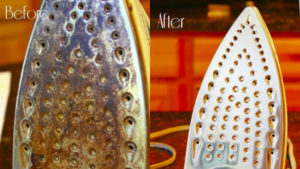
- You can remove scorch marks from the soleplate of your iron by scrubbing it with a paste made by heating up equal parts vinegar and salt in a small pan. Use a rag dipped in clean water to wipe away the remaining residue.
Brush off stains on suede
To eliminate a fresh grease spot on a suede jacket, skirt, or shoes, gently brush it with a soft toothbrush dipped in white vinegar. Let the spot air-dry, then brush with a suede brush. Repeat if necessary.
Remove perspiration discoloration
Scrub the material with a paste made from 2 parts white vinegar to 3 parts baking soda. Let the paste set for half an hour before washing (this also works on ink stains). This approach also works to remove light mildew stains from clothing. You can also pour a bit of vinegar directly on the stain and rub into the fabric before washing.
Eliminate insects around the garden
Fill a 2-liter soda bottle with 1 cup apple cider vinegar and 1 cup sugar. Next, slice up a banana peel into small pieces, put them in the bottle, add 1 cup cold water, and shake it up. Tie a piece of string around the neck of the open bottle and hang it from a low tree branch (or place it on the ground to trap and kill six-legged freeloaders). Replace used traps with new ones as needed.
Keep out four-legged creatures
Some animals—including cats, deer, dogs, rabbits, and raccoons—can’t stand the scent of vinegar even after it has dried. You can keep these unauthorized visitors out of your garden by soaking several recycled rags in white vinegar and placing them on stakes around your veggies. Resoak the rags about every 7-10 days.
Give ants the boot
Pour equal parts water and white vinegar into a spray bottle. Then spray it on anthills and around areas where you see the insects. Ants hate the smell of vinegar. It won’t take long for them to move on to better-smelling quarters.
Clean off bird droppings
Spray with full-strength apple cider vinegar. Or pour the vinegar onto a rag and wipe them off.
Revive your paintbrushes
To remove dried-on paint from a synthetic-bristle paintbrush, soak it in full-strength white vinegar until the paint dissolves and the bristles are soft and pliable, then wash in hot, soapy water.
Keep cut flowers fresh
Mix 2 tablespoons apple cider vinegar and 2 tablespoons sugar with the vase water before adding flowers. Be sure to change the water (with more vinegar and sugar, of course) every few days to enhance your flowers’ longevity.
FINER POINT
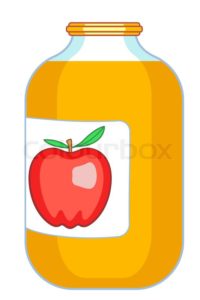 I’ve been converted (by the People’s Pharmacy) to the use of Apple Cider Vinegar (ACV) as an anti-inflammatory aid. Each morning I add a few dollops of honey to a glass of water and microwave for 30 seconds (to help dissolve the honey), then stir in two tablespoons of red cider vinegar and drink it down as I put away clean dishes from the previous night’s meal.
I’ve been converted (by the People’s Pharmacy) to the use of Apple Cider Vinegar (ACV) as an anti-inflammatory aid. Each morning I add a few dollops of honey to a glass of water and microwave for 30 seconds (to help dissolve the honey), then stir in two tablespoons of red cider vinegar and drink it down as I put away clean dishes from the previous night’s meal.
I have found that this simple, inexpensive supplement to my overall arthritis regime helps keep at bay the joint aches that seem to have accompanied my increased maturity. And it does a whole lot more, too, evidently! Here’s a link to other health-related uses for ACV: https://draxe.com/apple-cider-vinegar-uses/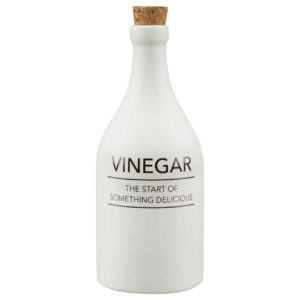
Vinegar, ho!
 With many thanks for your good efforts!
With many thanks for your good efforts!




